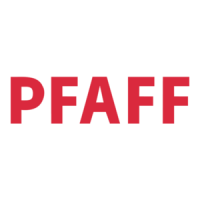8 Feed motion
8.1. Feed lifting motion:
The rising feed dog and the point
of
the descending needle should reach the surface
of
the needle plate simultaneously.
8.2. Feed driving motion:
8.2.1. Set the machine for its maximum stitch length.
8.2.2. Adjust the feed driving eccentric on the arm shaft so that the needle bar (and the
feed dog), after the needle has risen
0.6 mm from the lowest point
of
its stroke, will
not make any perceptible motion as you move the feed regulator up and down
between its ultimate positions (for the longest feed stroke forward and backward).
8.2.3. To obtain a more favorable feed motion, this basic setting may be modified slightly.
9 .1. There should be a clearance
of
6 to 7 mm, about
Y4
inch, between the needle plate
and the raised sewing foot. A larger clearance is possible for certain subclasses,
provided a longer needle is used.
9 .2. When the needle bar is at the lowest point
of
its stroke, the needle holder must not
strike the raised sewing foot.
9.3.
Orient the presser bar so that the needle is centered in the slot
of
the sewing foot.
9.4. When the sewing foot is lowered, its sole should rest on the needle plate evenly.
9.5. The presser bar should exert the full amount
of
pressure on the needle plate (the
presser bar lifter has a slight amount
of
play when it is inoperative). Take a thin
piece
of
paper or a piece
of
delicate material to check whether the sewing foot exerts
the full amount
of
pressure and rests on the needle plate evenly.
9.6. The amount
of
pressure exerted by the sewing foot should be adapted to the type
of
fabric being sewn and the sewing speed.
If
the sewing foot pressure is set
incorrectly, the following sewing troubles may occur.
(a) Pressure too strong: the material is damaged by the feed dog: the material
is stretched along the seam line (seam puckering); the top and bottom plies
are disarranged so that they will not finish out evenly
(b) Pressure to weak: the material may be damaged because it is not firmly
engaged by the feed dog; at higher speeds, the material is not held securely
so that accurate guidance is impossible; one ply creeps ahead
of
another;
skipped stitches, irregular feeding.
5

